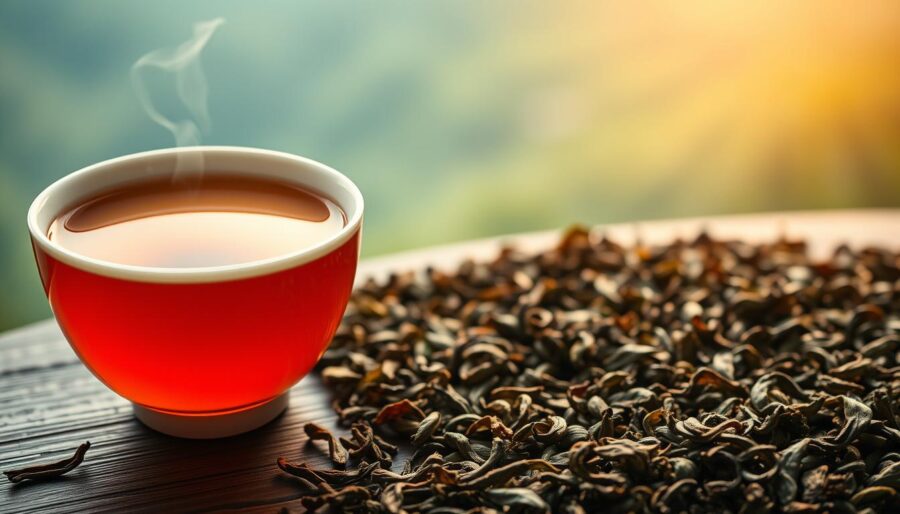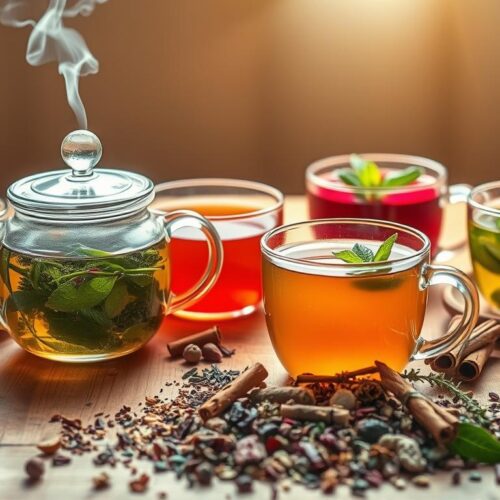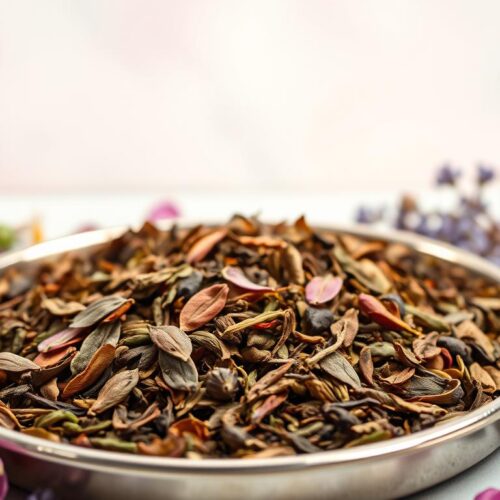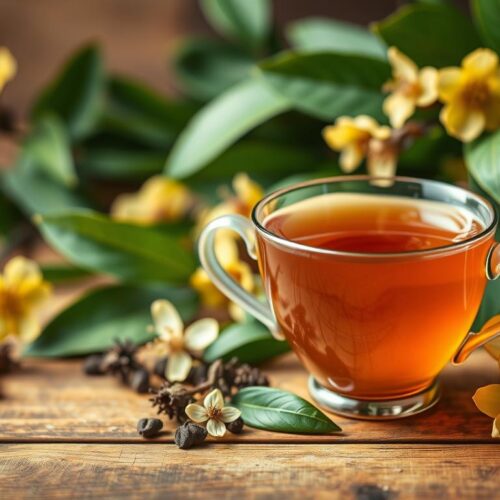You’re stepping into the world of a classic Chinese tea. It is between green and black in taste, aroma, and caffeine level. Oolong tea is partly oxidized leaves from the Camellia sinensis plant. It offers a full flavor without being too heavy. Even though tea is the second most loved drink after water, oolong makes up only about 2% of it. Yet, it’s packed with benefits.
In this guide, we’ll see how oolong gets its unique taste. This happens in Fujian and Taiwan where it’s partially dried and oxidized. The caffeine in oolong can range from 37 to 55 mg per 8 ounces. Brewing it at 185–205°F brings out its complexities. We’ll also look into what research says about its health perks. These include support for the heart and metabolism and mental sharpness from caffeine and L-theanine.
If you like the floral Tieguanyin or the earthy Wuyi Rock teas, we’ve got you covered. You’ll learn how to choose, brew, and taste them. By the end, you’ll be well acquainted with oolong tea. You’ll understand how it’s made and how to treasure its unique qualities. Plus, you’ll discover genuine health benefits that you can incorporate into your life.
Are you new to Chinese tea or already a lover? This guide is for you. It will help you compare tea styles, perfect your brewing, and understand the science of tea’s health benefits. Let’s dive into its origins and journey from garden to cup.
What is Oolong Tea and Its Origins?
People often ask, what is oolong tea? It’s a Chinese tea that’s partly oxidized, sitting between green and black tea in style. This unique position creates a variety of tastes and scents. Lightly oxidized versions are fresh and floral, while darker ones are warmer and can have fruity or woody notes.
The term “wūlóng,” translating to dark dragon, has many origin stories. One story is about Dragon-Phoenix cakes in the Song Dynasty, leading to the loose-leaf tea tradition. Another talks about its roots in Fujian’s Wuyi Mountains, with tales like Wuyi Tea Song. There’s even a story of a farmer who invented the tea by accident, after getting distracted by a deer.
Over time, Fujian became known for crafting oolong, using specific techniques of withering and partial fermentation. Its neighbors also developed unique versions, like Anxi’s Tie Guan Yin or Taiwan’s high-mountain Gaoshan. There’s even a spring-picked variety in Taiwan known as Milk Oolong.
Recent studies, including those by Lin and Li, delve into the flavors of oolong. They examine the volatile compounds that define each variety, showing how the land and processing affect its taste. This research tells us why each oolong tea is unique and how they offer different benefits.
Discovering oolong tea is a journey into different lands and traditions. From the cliffs of Wuyi to the hills of Anxi and Taiwan’s mountains, its makers carefully control oxidation. This process brings out the essence of the landscape in each leaf, connecting Chinese tea history, diverse styles, and oolong’s widespread charm.
The Oolong Tea Production Process
To understand oolong tea, start with fresh leaves picked at sunrise. They wither on bamboo trays, edges becoming soft and grassy smell fading. Then, gentle tossing bruises the edges, starting partial oxidation. This is key to classic Chinese tea making.
Oxidation is carefully watched. When the leaf smells floral or nutty, heat is used to stop the process. The leaves are then pan-fried, rolled, and dried. Some oolong teas, like Tie Guan Yin, are slowly roasted for up to 60 hours. This adds deep honeyed flavors.
The climate and altitude greatly affect oolong tea. Cool, high mountains in Taiwan make teas that are bright and silky. Warmer valleys in Fujian produce teas with rich, baked tones. Also, using hotter water for brewing pulls more caffeine from the tea.
The way oolong tea is made also affects how you should brew it. Using a preheated gaiwan for brewing lets you “wake” the leaves with a quick rinse. This shows off the careful rolling and roasting done at the factory.
| Stage | What Happens | Sensory Outcome | Notes on Caffeine | Comparison: oolong tea vs green tea |
|---|---|---|---|---|
| Withering | Leaves rest and lose moisture. | Softer texture, reduced grassy sharpness. | Caffeine remains; concentration rises as water leaves. | Green tea also withers briefly, but moves fast to kill-green. |
| Bruising/Tossing | Edges are shaken to start partial oxidation. | Floral and fruity precursors emerge. | No major change yet; sets up later extraction. | Green tea skips bruising to avoid oxidation. |
| Partial Oxidation | Controlled rest develops flavor compounds. | Range from green-floral to amber-roasted. | Similar base caffeine to green; flavor shifts affect perception. | Green tea is unoxidized; black tea is fully oxidized. |
| Fixing (Pan-Fry) | High heat stops enzymes and locks aroma. | Clean finish, stable leaf color. | Heat doesn’t remove caffeine; brewing later controls yield. | Both oolong and green use heat, but timing and degree differ. |
| Rolling | Leaves are shaped into strips or tight balls. | Enhanced body and layered steeps. | Compact shapes can release caffeine across multiple infusions. | Green tea rolls more lightly to keep a fresh snap. |
| Roasting/Drying | Slow roast or final dry sets moisture level. | From creamy to toasty; Tie Guan Yin may roast long. | Brew temp drives extraction: warmer water, more caffeine in cup. | Green tea dries without deep roast, keeping grassy notes. |
Oolong tea is between green and black tea, offering a range of tastes with less bitterness. Understanding the production process helps you know more about teas from areas like Anxi, Wuyi, or Alishan. This knowledge helps you explore oolong tea’s place in Chinese tea tradition.
Nutritional Components of Oolong Tea
Oolong tea gives you a light, nutrient-rich drink. Each cup has hardly any calories and no big nutrients. Yet, it’s packed with trace minerals. Fluoride is a star here, protecting your teeth by fighting cavities, plaque, and gingivitis. You also find a bit of potassium, magnesium, calcium, phosphorus, and sodium. These add to the tea’s health perks without any sugar or fat.
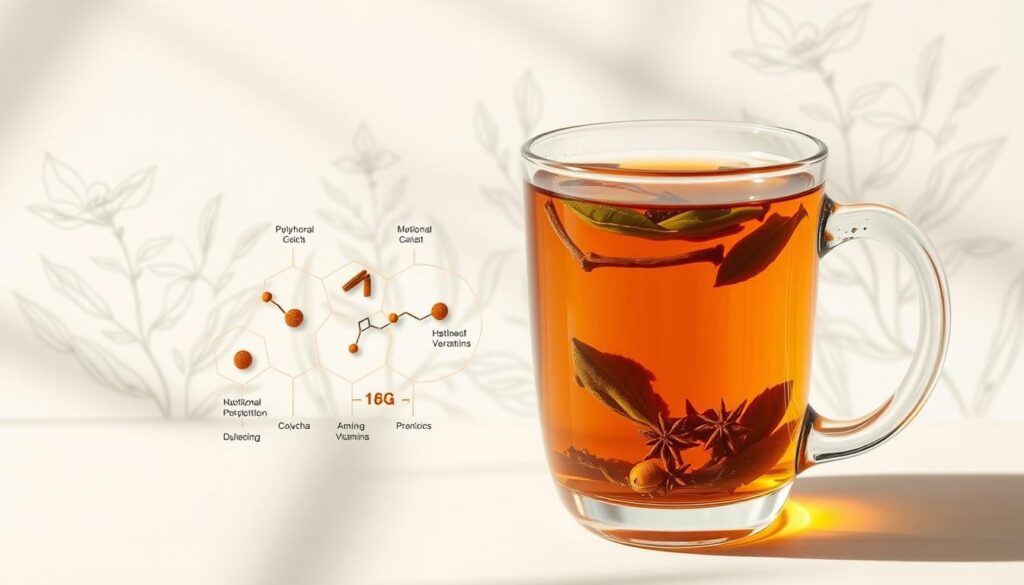
Oolong tea is full of polyphenols like EGCG, and also theaflavins, thearubigins, and theasinensins. These antioxidants combat oxidative stress and support your immune system. There’s L-theanine too, which helps you stay calm and focused. And there’s natural caffeine and theobromine for alertness and gentle effects on your blood flow. All these benefits are what make oolong tea special in both traditional Chinese tea culture and modern nutrition.
Oolong tea’s compounds work with your gut bacteria. They break down into metabolites that might help with fat and sugar handling, and digestion. This adds to the tea’s health benefits, making your daily cup both simple and enjoyable.
| Component | Role in the Body | What You Get from Oolong Tea |
|---|---|---|
| Fluoride | Supports enamel strength and oral hygiene | Natural fluoride from leaves linked to fewer cavities and less plaque |
| Potassium, Magnesium, Calcium | Electrolyte balance, muscle and nerve function, bone support | Trace amounts that contribute without extra calories |
| Polyphenols (EGCG, theaflavins) | Antioxidant and anti-inflammatory activity | Balanced profile positioned between green and black tea |
| L-theanine | Relaxation and attention | Smoother focus when paired with caffeine |
| Caffeine and Theobromine | Alertness and circulatory effects | Moderate lift without heavy jitteriness |
Because it’s between green and black tea, oolong has a balanced, strong mix of phenols. You can taste and feel this balance in every cup. It gives you steady energy and clear thinking. This makes oolong tea an easy pick daily, combining practical benefits with a long history of health use.
Health Benefits of Oolong Tea
Oolong tea gives you a nice boost. It has caffeine and L-theanine which help you focus and stay calm. Studies say this mix helps with attention, mood, and faster thinking. Older people who drink it tend to keep their smarts longer.
Oolong tea is good for managing weight. Research says caffeine boosts fat burning. Oolong’s antioxidants might help with gut health and lower fat. But, don’t drink it too late to avoid sleep issues.
It’s also great for the heart. Drinking it can improve blood pressure and heart health. Oolong’s polyphenols are a smart addition to heart-healthy diets. Adding it to daily habits that include exercise and eating well is easy.
Choosing between oolong and green tea depends on what you prefer. Both have health benefits. Oolong has extra compounds from being partly fermented. Green tea tastes light and grassy, while oolong can taste floral or toasty, making it easier to drink regularly.
Pairing tea with your daily routine is simple. Have it with protein in the morning for energy. Swap an afternoon soda for tea. See how you feel after two weeks, then tweak as needed.
| Focus Area | What You May Notice | Key Compounds | Practical Tip |
|---|---|---|---|
| Weight & Metabolism | Higher fat oxidation and easier calorie control | Caffeine, polyphenols, fermentation byproducts | Brew before a walk or workout for added lift |
| Heart & Vascular | Support for healthy blood pressure and vessel tone | Antioxidants, catechins | Choose unsweetened oolong tea with meals |
| Cognition & Mood | Improved alertness, steadier focus, calmer energy | Caffeine plus L-theanine | Use as an afternoon pick-me-up instead of soda |
| Oolong Tea vs Green Tea | Comparable tea health benefits with different flavor profiles | Shared catechins; oolong’s partial fermentation | Alternate cups to find what you enjoy most |
Drink oolong tea earlier if caffeine bothers you. Start with lightly brewed leaves to see how you feel. With regular drinking, oolong tea fits well with a healthy lifestyle.
Oolong Tea and Skin Health
You want your skin to be calm, bright, and strong. This starts with help from the inside. Chinese tea polyphenols act as antioxidants. They tackle inflammation, which are main causes of dull skin and wrinkles. Including oolong in your daily routine aligns with your skin care goals.
The benefits of oolong tea come from unique elements that form during partial oxidation. Theasinensins and other special polyphenols in oolong fight oxidative stress. This stress reduces skin firmness. Using oolong tea together with sunscreen, a healthy diet, and good sleep helps your skin stay smooth.
Your circulation is important too. Substances like theobromine in oolong tea support good blood flow. This brings necessary nutrients to the skin. As a result, your skin can look more even and alive through all seasons.
Many seek comfort for sensitive skin. While studies on certain skin issues are ongoing, chinese tea’s anti-inflammatory effects suggest it can calm your skin. These benefits of tea are overall, helping your skin care plan but not replacing doctor’s advice.
To start a simple routine, drink one to two cups of oolong tea every day and keep hydrated. Combine these tea benefits with soft cleansers, mineral SPF from EltaMD or La Roche-Posay, and a moisturizer suitable for your skin. Small, daily actions can make your skin look healthy over time.
- Brew tea fresh for the most antioxidants; don’t use boiling water on the delicate leaves.
- Eat foods rich in vitamin C to help keep your collagen strong.
- Avoid too much sugar, which can reduce the benefits of the tea.
How to Brew the Perfect Cup of Oolong Tea
Start with hot water just off the boil to honor oolong tea. Heat your cup or teapot first to keep the heat. For a cup, add about 2 teaspoons of tea, around 2 grams, to 8.8 ounces (250 mL) of water at about 205°F (95°C). Steep it for 3 to 5 minutes, taste it, then adjust if needed. This easy routine is key to brewing balanced oolong tea.
Light oolong teas are best at 185–200°F (85–93°C) for 2 to 4 minutes. Darker teas prefer hotter water, 200–205°F (93–96°C), and a longer time, 4 to 6 minutes. By brewing multiple times, you’ll discover different flavors, from floral to honeyed to roasted. This technique avoids bitterness, enhancing the tea’s benefits.
For an authentic touch, use a porcelain gaiwan. Warm it up, put in about 4 grams of tea, and rinse the leaves quickly. Start brewing at 205°F (95°C). Begin with 15 seconds, then increase to 25, 40, 60, 80, and 100 seconds. Small cups are great for observing the tea’s flavor changes through each steep.
Choose a kettle with precise temperature control, like those from Fellow or Breville, to ensure consistency. Drink oolong tea during the day if you’re cautious about caffeine. This way, you can enjoy oolong without disrupting your sleep. This careful approach allows you to enjoy oolong with both comfort and focus in mind.
If you prefer stronger tea, add a little more leaves rather than steeping it longer. If the tea tastes too strong, lower the heat or steep it for a shorter time next time. These small changes help you keep the tea’s unique taste and get consistent results.
Quick guide: preheat, measure, pour, taste, refine. Follow these steps to master brewing oolong tea at home, whether you prefer lighter teas or the deeper roasted ones that show off traditional Chinese tea skills.
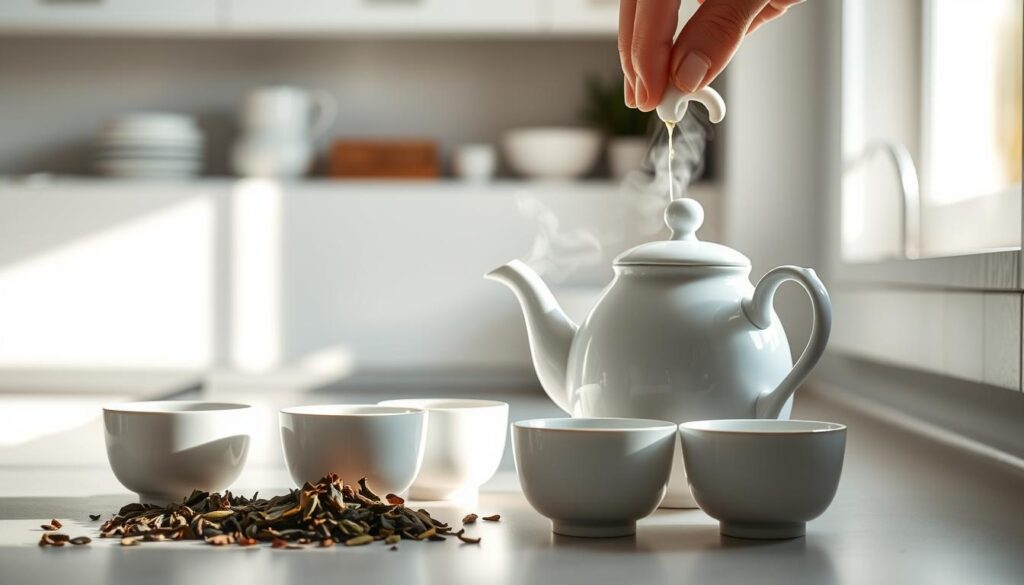
| Method | Leaf Amount | Water | Temp | Steep Plan | Notes |
|---|---|---|---|---|---|
| Cup/Teapot | 2 tsp (≈2 g) | 8.8 oz (250 mL) | 185–205°F (85–96°C) | Lighter: 2–4 min; Darker: 4–6 min | Simple, clear flavors; highlights everyday oolong tea benefits |
| Gaiwan | ≈4 g | Small pours per infusion | ≈205°F (95°C) | 15s, 25s, 40s, 60s, 80s, 100s | Rinse to awaken leaves; multiple infusions reveal classic Chinese tea nuance |
| Timing & Caffeine | — | — | — | Daytime preferred | Avoid evening sessions to protect sleep while enjoying oolong tea |
Always use fresh water and keep your kettle and leaves clean. With a bit of practice, brewing oolong tea becomes easy, and each cup will share a story of aroma, texture, and gentle energy.
Popular Oolong Tea Varieties
Oolong tea shines in the world of Chinese tea. Classics are loved for their aroma, origin, and craftsmanship. They let you confidently compare oolong and green tea, understanding the special oolong benefits from oxidation and roast.
Tie Guan Yin, from Anxi, Fujian, is also called Iron Goddess of Mercy. It brings a floral, orchid-like taste with a breezy feel. Traditional roasting may take up to 60 hours, adding richness but keeping the fresh scent. BornTea highlights this tea for its direct sourcing, delivering its famous scent and smooth finish.
Da Hong Pao, a celebrated Wuyi Rock Tea, comes from the Wuyi Mountains. It’s known for its dark, mineral flavor and smoky hints. Being rare, it’s one of the priciest Chinese teas. It offers a deep sweetness, showcasing oolong’s unique body and texture over green tea.
Oriental Beauty (Bai Hao) is a top Taiwanese oolong that’s highly oxidized. It tastes sweet like honey and fruit. The leafhopper insect bites before picking cause a unique oxidation, leading to a smooth texture and full flavor. Many feel these traits are part of oolong’s health benefits, along with a mild boost from caffeine.
More famous teas extend your choices. Phoenix Dan Cong from Guangdong is rich and fragrant. High Mountain Oolong from central Taiwan is fresh and floral. Jin Xuan, or Milk Oolong, offers a creamy, buttery taste due to its special growth conditions. Every type demonstrates oolong’s blend of green and black tea traditions in China.
Studies prove these differences. Research by Li (2022) shows how Fenghuang Dan Cong, Tie Guan Yin, and Da Hong Pao differ in their aromatics. Wang et al. (2022) explain the changes in non-volatile compounds across growing regions. This means there are distinct tastes and aromas helping you pick oolong over green tea, matching the oolong benefits you want.
Enjoying Oolong Tea in Different Ways
Discover the beauty of oolong tea through tradition and everyday moments. To brew it the classic way, start with a gaiwan. First, warm the bowl, then add the tea leaves. A quick rinse will awaken them. Enjoy multiple short brews to see how the taste changes from fresh to rich.
If you prefer something easier, just use a cup or teapot and steep for 3–5 minutes. Serve it in tiny cups to fully enjoy the aroma with each sip. This method is perfect for busy days but still honors the elegance of Chinese tea culture.
Each brewing session brings a new experience. Lighter oolongs from high mountains are initially floral and become smoothly sweet. Darker, roasted types reveal a complexity of minerals and chocolate flavors over time. Recognizing these changes can deepen your appreciation and skill in brewing oolong tea.
Caffeine content varies from about 24–72 mg per 8 oz cup, so consider when to enjoy it. Many find the late morning or early afternoon ideal for the gentle energy boost and focus enhancement from L-theanine. This timing also helps enjoy tea’s health benefits without affecting sleep.
Think about aroma when pairing foods. Oolong teas with floral and fruity notes are delightful with berries or seafood. Wuyi-style oolong, on the other hand, goes great with roasted nuts or dark chocolate. These pairings complement the complex flavors found in Chinese tea and can amplify its health perks during a meal.
Create a personal tea ritual. Heat your cups, inhale the aromatic steam, and compare each infusion. Whether you’re setting up for a full gongfu tea ceremony or enjoying a simple mug, paying close attention and taking your time elevates the experience of oolong tea.
- Gaiwan method: short, repeated steeps; rinse, then pour quickly.
- Western cup: 3–5 minutes for ease and steady flavor.
- Timing: enjoy earlier in the day to balance caffeine and tea health benefits.
- Food pairings: fruit and seafood for floral styles; nuts and dark chocolate for roasty styles.
Tips for Buying and Storing Oolong Tea
When buying oolong tea, seek out experts who share the tea’s origins and types. Look for Anxi Tie Guan Yin or Wuyi Da Hong Pao from sellers who mention specific farms or areas and when they harvested the tea. Jin Xuan picked in spring can taste creamy, while more roast or oxidation brings nutty and mineral flavors. Choosing brands that are open about where their tea comes from, like BornTea with its Tie Guan Yin from Anxi, Fujian, ensures you’re getting quality tea. Whole, even leaves and a fresh scent mean it’s likely genuine.
Focus on the details for the best choice. Good sellers will tell you about the tea’s oxidation and roast levels and might include scientific evidence. Research by Li (2022), Wang (2022), and Lin (2023) found unique markers in authentic regional teas. By choosing vendors that explain the tea’s background and how it’s made, you lessen the chance of getting mixed teas pretending to be from a single origin. This openness leads to better taste and tea that’s more beneficial for your health.
Store oolong tea in places without air, light, warmth, or dampness. Use containers that don’t let light in and are airtight, and put them somewhere cool and dry. Steer clear of areas with strong smells because tea picks up odors quickly. Lightly oxidized teas can remain fresh for several months if sealed properly; roasted types last longer but also need to be well sealed. Some roasted oolong teas can get better with age if stored correctly.
Proper storage helps control caffeine and the flavor you get. Brewing at around 205°F extracts the flavors well, making every cup of tea come with expected health benefits. Don’t buy too much at once so your tea doesn’t lose its freshness. Smart buying and storing give you tea with clear origins, rich scent, and dependable health advantages every time.

